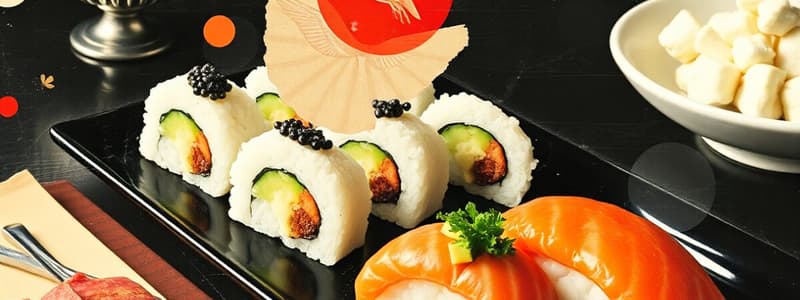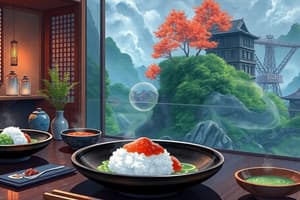Podcast
Questions and Answers
What is the primary focus of the zensai course in an omakase meal?
What is the primary focus of the zensai course in an omakase meal?
- A starter featuring sashimi (correct)
- A variety of sushi rolls
- A dessert course with fruits
- A main course of grilled fish
Which fish is included in the 1st nigiri course?
Which fish is included in the 1st nigiri course?
- Otoro
- Chutoro
- Kanpachi
- Hirame (correct)
What distinguishes the fish in the 3rd nigiri course?
What distinguishes the fish in the 3rd nigiri course?
- They are all raw
- They are all light seared (correct)
- They are all bellies of fish
- They come with a sauce
Which item is NOT part of the premium course?
Which item is NOT part of the premium course?
What purpose does the madai consommé serve in the omakase?
What purpose does the madai consommé serve in the omakase?
In the small plates course, what is the primary ingredient in the kanpachi tartar?
In the small plates course, what is the primary ingredient in the kanpachi tartar?
What is the main feature of the chutoro quail egg toast in the small plates course?
What is the main feature of the chutoro quail egg toast in the small plates course?
Which flavor profile is highlighted in the premium course with the uni trout roe?
Which flavor profile is highlighted in the premium course with the uni trout roe?
What is the correct order of fish in the 2nd nigiri course from left to right?
What is the correct order of fish in the 2nd nigiri course from left to right?
What garnish is found on top of the A5 wagyu in the premium course?
What garnish is found on top of the A5 wagyu in the premium course?
Which of the following fish is served first in the 2nd nigiri course?
Which of the following fish is served first in the 2nd nigiri course?
What is unique about the dishes served in the 3rd nigiri course?
What is unique about the dishes served in the 3rd nigiri course?
Which of the following items is included in the small plates course as the second option for premium?
Which of the following items is included in the small plates course as the second option for premium?
What is the last item presented in the premium course?
What is the last item presented in the premium course?
In which course is kanpachi tartar featured, and how is it recommended to be eaten?
In which course is kanpachi tartar featured, and how is it recommended to be eaten?
What primary ingredient characterizes the ceviche served as the second item in the small plates course?
What primary ingredient characterizes the ceviche served as the second item in the small plates course?
What distinguishing feature is present in the 1st nigiri course compared to other nigiri courses?
What distinguishing feature is present in the 1st nigiri course compared to other nigiri courses?
Which component enhances the flavor of the sea urchin in the premium course?
Which component enhances the flavor of the sea urchin in the premium course?
How is the madai consommé best described in relation to the omakase meal?
How is the madai consommé best described in relation to the omakase meal?
What flavor profile is primarily associated with the 3rd nigiri course?
What flavor profile is primarily associated with the 3rd nigiri course?
Kao as kuttulu na male'le' i inada gi i 1st nigiri course?
Kao as kuttulu na male'le' i inada gi i 1st nigiri course?
Kao siha na item oncho' i chu-toro gi i small plates course?
Kao siha na item oncho' i chu-toro gi i small plates course?
Kao siha na ikan na manaog gi i premium course?
Kao siha na ikan na manaog gi i premium course?
Kao siha na ingredient gi i king salmon ceviche?
Kao siha na ingredient gi i king salmon ceviche?
Kao i kanpachi tartar hit na item gi i small plates course?
Kao i kanpachi tartar hit na item gi i small plates course?
Hiyong i inada, para u na'cho' '?
Hiyong i inada, para u na'cho' '?
Kao siha na ikan na di'bai i chu-toro?
Kao siha na ikan na di'bai i chu-toro?
Hihong i takto na ingredient gi i A5?
Hihong i takto na ingredient gi i A5?
Kao siha na unguli gi i king salmon ceviche?
Kao siha na unguli gi i king salmon ceviche?
Kao hafa mas ti si'ngan i akami gi i nigiri course?
Kao hafa mas ti si'ngan i akami gi i nigiri course?
Flashcards are hidden until you start studying
Study Notes
Omakase Course Overview
- Omakase means "I'll leave it up to you," allowing chefs to showcase their creativity through a multi-course meal.
Zensai (Starter)
- Zensai translates to "starter" in Japanese, beginning the dining experience with lightly seasoned sashimi.
1st Nigiri Course
- Features a selection of white fish:
- Madai (sea bream) on the left
- Buri (adult yellowtail) in the middle
- Hirame (flounder) on the right
- Recommended to eat from left to right for optimal flavor experience.
2nd Nigiri Course
- Consists of three cuts of bluefin tuna:
- Akami: lean part of bluefin tuna on the left
- Chutoro: medium fatty part in the middle
- Otoro: fatty belly of the bluefin on the right.
3rd Nigiri Course
- This course features lightly seared items:
- Kinmedai (golden eye snapper) on the left
- Sake aburri (seared salmon) in the middle
- Hotate aburri (seared scallop) on the right.
Premium Course
- Offers luxurious ingredients:
- Uni (sea urchin from Hokkaido) with rainbow trout roe and yuzu zest on the left
- Harami (belly cut), specifically sake toro (salmon belly) in the middle
- A5 wagyu beef topped with shaved cured egg yolk, truffle pâté, and ginger on the right.
Madai Consommé
- A complimentary concentrated madai bone broth serves as a palate cleanser during the omakase experience.
Small Plates Course
- Comprises several items:
- Kanpachi tartar: young yellowtail with blood orange miso vinaigrette.
- Ceviche: assorted white fish with ceviche sauce and avocado cream.
- Premium king salmon ceviche served with blood oranges.
- Chutoro quail egg toast: lightly buttered toast, medium fatty tuna, truffle aïoli, quail egg, and pecorino cheese.
- Lobster meshi: lobster on sushi rice with nikiri (sweet soy sauce) and seasonings.
Matcha Sundae (Dessert)
- Features a scoop of Japanese green tea ice cream accompanied by fried banana, pound cake, strawberries, powdered sugar, and shaved chocolate.
Celebration Sushi
- Special sushi option for birthdays and anniversaries, includes Angawa (flounder fin).
Omakase Course Overview
- Omakase means "I'll leave it up to you," allowing chefs to showcase their creativity through a multi-course meal.
Zensai (Starter)
- Zensai translates to "starter" in Japanese, beginning the dining experience with lightly seasoned sashimi.
1st Nigiri Course
- Features a selection of white fish:
- Madai (sea bream) on the left
- Buri (adult yellowtail) in the middle
- Hirame (flounder) on the right
- Recommended to eat from left to right for optimal flavor experience.
2nd Nigiri Course
- Consists of three cuts of bluefin tuna:
- Akami: lean part of bluefin tuna on the left
- Chutoro: medium fatty part in the middle
- Otoro: fatty belly of the bluefin on the right.
3rd Nigiri Course
- This course features lightly seared items:
- Kinmedai (golden eye snapper) on the left
- Sake aburri (seared salmon) in the middle
- Hotate aburri (seared scallop) on the right.
Premium Course
- Offers luxurious ingredients:
- Uni (sea urchin from Hokkaido) with rainbow trout roe and yuzu zest on the left
- Harami (belly cut), specifically sake toro (salmon belly) in the middle
- A5 wagyu beef topped with shaved cured egg yolk, truffle pâté, and ginger on the right.
Madai Consommé
- A complimentary concentrated madai bone broth serves as a palate cleanser during the omakase experience.
Small Plates Course
- Comprises several items:
- Kanpachi tartar: young yellowtail with blood orange miso vinaigrette.
- Ceviche: assorted white fish with ceviche sauce and avocado cream.
- Premium king salmon ceviche served with blood oranges.
- Chutoro quail egg toast: lightly buttered toast, medium fatty tuna, truffle aïoli, quail egg, and pecorino cheese.
- Lobster meshi: lobster on sushi rice with nikiri (sweet soy sauce) and seasonings.
Matcha Sundae (Dessert)
- Features a scoop of Japanese green tea ice cream accompanied by fried banana, pound cake, strawberries, powdered sugar, and shaved chocolate.
Celebration Sushi
- Special sushi option for birthdays and anniversaries, includes Angawa (flounder fin).
Fish and Seafood Varieties
- Inada: Refers to baby yellowtail, a juvenile version prized for its delicate flavor and texture.
- Madai: Known as sea bream, a popular sushi fish valued for its firm, white flesh and slightly sweet taste.
- Buri: The adult yellowtail, known for its rich flavor and higher fat content compared to its younger counterpart, Inada.
- Hirame: A type of flounder renowned for its mild flavor and thin, translucent fillets.
- Akami: Lean cut of bluefin tuna, noted for its deep red color and rich umami flavor.
Fatty Tuna Varieties
- Chu-Toro: A medium fatty cut of tuna that offers a balance of rich flavor and tender texture.
- Otoro: The fattiest part of the tuna belly, celebrated for its buttery texture and melt-in-the-mouth quality.
Other Notable Seafood
- Kinmedai: Also known as golden eye snapper, distinguished by its beautiful color and firm, white flesh.
- Sake: Refers to salmon, a commonly used fish in sushi and sashimi known for its rich flavor and high omega-3 content.
- Hotate: Scallops that are sweet and tender, often served raw as sashimi or lightly seared.
Specialty and Unique Offerings
- Uni: Sea urchin roe, renowned for its creamy texture and oceanic flavor, a delicacy in Japanese cuisine.
- Harami: Salmon belly, which is known for its high fat content and rich flavor, making it a sought-after sushi ingredient.
- A5: Highest grade of Wagyu beef known for its exceptional marbling, flavor, and tenderness, often used in high-end sushi.
Culinary Delights
- Kanpachi Tartar: Made from young yellowtail, this dish offers a fresh and flavorful preparation that emphasizes the fish's natural taste.
- King Salmon Ceviche: A raw preparation of king salmon, marinated in citrus juices, highlighting the fish's rich flavor and firm texture.
- Chutoro Toast: A dish featuring medium fatty tuna on toast, showcasing a blend of textures and flavors in a gourmet format.
- Lobster Meshi: A dish that typically consists of rice topped with lobster, offering luxurious flavors and a satisfying mouthfeel.
Fish and Seafood Varieties
- Inada: Refers to baby yellowtail, a juvenile version prized for its delicate flavor and texture.
- Madai: Known as sea bream, a popular sushi fish valued for its firm, white flesh and slightly sweet taste.
- Buri: The adult yellowtail, known for its rich flavor and higher fat content compared to its younger counterpart, Inada.
- Hirame: A type of flounder renowned for its mild flavor and thin, translucent fillets.
- Akami: Lean cut of bluefin tuna, noted for its deep red color and rich umami flavor.
Fatty Tuna Varieties
- Chu-Toro: A medium fatty cut of tuna that offers a balance of rich flavor and tender texture.
- Otoro: The fattiest part of the tuna belly, celebrated for its buttery texture and melt-in-the-mouth quality.
Other Notable Seafood
- Kinmedai: Also known as golden eye snapper, distinguished by its beautiful color and firm, white flesh.
- Sake: Refers to salmon, a commonly used fish in sushi and sashimi known for its rich flavor and high omega-3 content.
- Hotate: Scallops that are sweet and tender, often served raw as sashimi or lightly seared.
Specialty and Unique Offerings
- Uni: Sea urchin roe, renowned for its creamy texture and oceanic flavor, a delicacy in Japanese cuisine.
- Harami: Salmon belly, which is known for its high fat content and rich flavor, making it a sought-after sushi ingredient.
- A5: Highest grade of Wagyu beef known for its exceptional marbling, flavor, and tenderness, often used in high-end sushi.
Culinary Delights
- Kanpachi Tartar: Made from young yellowtail, this dish offers a fresh and flavorful preparation that emphasizes the fish's natural taste.
- King Salmon Ceviche: A raw preparation of king salmon, marinated in citrus juices, highlighting the fish's rich flavor and firm texture.
- Chutoro Toast: A dish featuring medium fatty tuna on toast, showcasing a blend of textures and flavors in a gourmet format.
- Lobster Meshi: A dish that typically consists of rice topped with lobster, offering luxurious flavors and a satisfying mouthfeel.
Studying That Suits You
Use AI to generate personalized quizzes and flashcards to suit your learning preferences.


